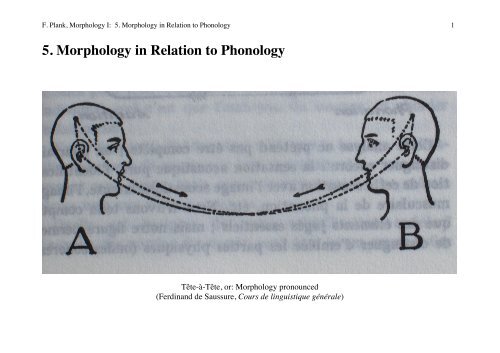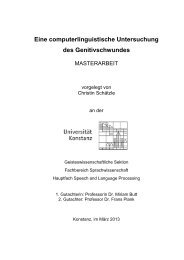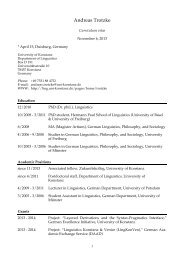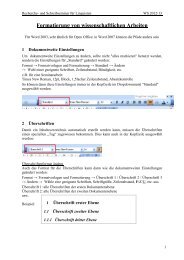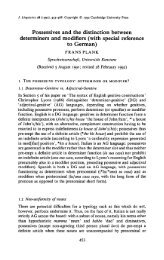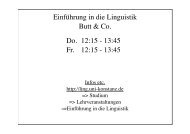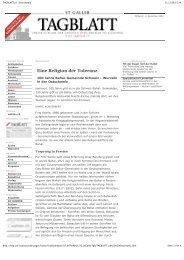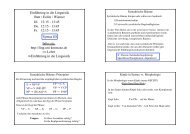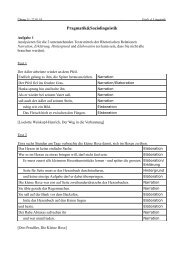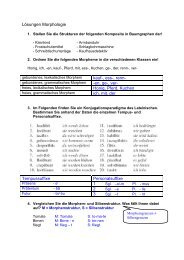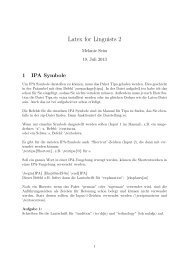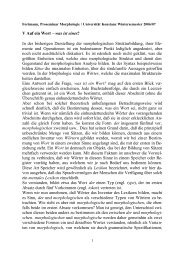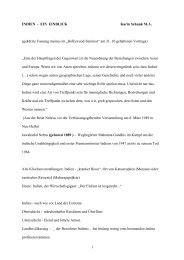5. Morphology in Relation to Phonology
5. Morphology in Relation to Phonology
5. Morphology in Relation to Phonology
You also want an ePaper? Increase the reach of your titles
YUMPU automatically turns print PDFs into web optimized ePapers that Google loves.
F. Plank, <strong>Morphology</strong> I: <strong>5.</strong> <strong>Morphology</strong> <strong>in</strong> <strong>Relation</strong> <strong>to</strong> <strong>Phonology</strong> 1<br />
<strong>5.</strong> <strong>Morphology</strong> <strong>in</strong> <strong>Relation</strong> <strong>to</strong> <strong>Phonology</strong><br />
Tête-à-Tête, or: <strong>Morphology</strong> pronounced<br />
(Ferd<strong>in</strong>and de Saussure, Cours de l<strong>in</strong>guistique générale)
F. Plank, <strong>Morphology</strong> I: <strong>5.</strong> <strong>Morphology</strong> <strong>in</strong> <strong>Relation</strong> <strong>to</strong> <strong>Phonology</strong> 2<br />
<strong>5.</strong>1. <strong>Morphology</strong> before phonology, step-by-step, hand-<strong>in</strong>-hand<br />
<strong>Morphology</strong> is responsible (<strong>in</strong> cooperation with the lexicon and syntax)<br />
for the expression of mean<strong>in</strong>gs. For their dist<strong>in</strong>ctive expression:<br />
l<strong>in</strong>guistic structures are systems of contrasts (e.g., PLURAL means<br />
someth<strong>in</strong>g different when part of a two-way or of a three-way system of<br />
NUMBER contrasts, SG - PL or SG - DU - PL).<br />
What phonology is responsible for is that these mean<strong>in</strong>gs, as expressible<br />
and dist<strong>in</strong>guishable courtesy of the lexicon (= basic units) and of<br />
morphology and syntax (= constructions) are (i) (easily) pronounceable<br />
and (ii) (easily) perceivable.<br />
It follows from this division of labour that morphology ought <strong>to</strong> have<br />
priority over phonology: first morphology (with lexicon and syntax)<br />
needs <strong>to</strong> provide forms-<strong>in</strong>-constructions, then phonology can see <strong>to</strong> it<br />
that they are (easily) pronounceable and perceivable.
F. Plank, <strong>Morphology</strong> I: <strong>5.</strong> <strong>Morphology</strong> <strong>in</strong> <strong>Relation</strong> <strong>to</strong> <strong>Phonology</strong> 3<br />
Therefore: <strong>Morphology</strong> should come before phonology <strong>in</strong> the real-time<br />
plann<strong>in</strong>g and execution of speech acts.<br />
But it is not quite as simple as that.<br />
When morphological constructions are complex, the phonology doesn̓t<br />
wait until the whole construction is assembled. Rather, phonology<br />
operates on constituent parts of constructions as they are assembled<br />
step-by-step – beg<strong>in</strong>n<strong>in</strong>g with their core (the stem or root) and the affix<br />
most closely jo<strong>in</strong>ed <strong>to</strong> it and gradually progress<strong>in</strong>g <strong>to</strong> the whole<br />
construction.<br />
Here is an example from English <strong>to</strong> show how morphological<br />
construction and phonology are <strong>in</strong>terlock<strong>in</strong>g.
F. Plank, <strong>Morphology</strong> I: <strong>5.</strong> <strong>Morphology</strong> <strong>in</strong> <strong>Relation</strong> <strong>to</strong> <strong>Phonology</strong> 4<br />
(i) nation-s /"neI.S(E)nz/ PL<br />
(ii) a. nation-al /"nœ.S(E).nEl/ ADJECTIVALISATION<br />
b. nation-al-ity /ˌnœ.S(E)."nœ.lI.tI/ NOMINALISATION<br />
c. nation-al-ity-s /ˌnœ.S(E)."nœ.lI.tIz/ PL<br />
When the plural of a noun like nation is formed, the phonology leaves<br />
the stem segmentally unaltered (other than, <strong>in</strong> <strong>in</strong>formal speech, perhaps<br />
suppress<strong>in</strong>g the schwa, as <strong>in</strong> the case of the basic form of the noun, <strong>to</strong>o)<br />
and regularly places stress on the first syllable (just as with the basic<br />
form of the noun itself: pluralisation doesn̓t add a syllable here that<br />
would have <strong>to</strong> be taken <strong>in</strong><strong>to</strong> account <strong>in</strong> stress<strong>in</strong>g);<br />
the exponent of PLURAL is realised as a voiced [z], com<strong>in</strong>g right after a<br />
voiced non-sibilant at the end of the stem.
F. Plank, <strong>Morphology</strong> I: <strong>5.</strong> <strong>Morphology</strong> <strong>in</strong> <strong>Relation</strong> <strong>to</strong> <strong>Phonology</strong> 5<br />
When a noun like nation is turned <strong>in</strong><strong>to</strong> an adjective by means of the<br />
suffix -al, the stem vowel needs <strong>to</strong> be phonologically adjusted <strong>to</strong> this<br />
environment: it is pronounced lax (or short);<br />
the suffix itself, be<strong>in</strong>g one of those suffixes that are unstressed, has the<br />
reduced vowel [E].<br />
When this adjective is then turned <strong>in</strong><strong>to</strong> a noun through suffix -ity, the<br />
stem vowel rema<strong>in</strong>s lax/short, but -ity is one of those suffixes that affect<br />
word stress: -ity words are pronounced with the ma<strong>in</strong> stress on the<br />
antepenultimate syllable, i.e., the syllable right before the suffix – which<br />
is pronounced with a full vowel, as all stressed syllables.<br />
When this multiply derived noun is now itself pluralised, what the<br />
phonology has achieved at the previous steps rema<strong>in</strong>s unaltered: stem<br />
vowel lax/short (as effectuated at the step of -al suffixation); stress<br />
retraction and full vowel (as effectuated at the step of -ity suffixation).
F. Plank, <strong>Morphology</strong> I: <strong>5.</strong> <strong>Morphology</strong> <strong>in</strong> <strong>Relation</strong> <strong>to</strong> <strong>Phonology</strong> 6<br />
All that rema<strong>in</strong>s for phonology <strong>to</strong> ensure at this last step is that the<br />
exponent of PLURAL is pronounced appropriately: voiced [z] after a<br />
voiced non-sibilant.<br />
The <strong>in</strong>terlock<strong>in</strong>g of morphology and phonology is modelled <strong>in</strong> the framework<br />
of Lexical <strong>Morphology</strong>/<strong>Phonology</strong>, with phonological rules associated with<br />
levels of construct<strong>in</strong>g words where they apply.<br />
See Kiparsky, Paul. 1982. Lexical morphology and phonology. In L<strong>in</strong>guistic<br />
Society of Korea (ed.), L<strong>in</strong>guistics <strong>in</strong> the morn<strong>in</strong>g calm, 3–91. Seoul: Hansh<strong>in</strong>.<br />
Consult e.g. Spencer 1991 for a more elaborate <strong>in</strong>troduction <strong>to</strong> level-order<strong>in</strong>g.<br />
More generally on the relationship between morphology and phonology also<br />
Booij 2005 (esp. Ch. 7).
F. Plank, <strong>Morphology</strong> I: <strong>5.</strong> <strong>Morphology</strong> <strong>in</strong> <strong>Relation</strong> <strong>to</strong> <strong>Phonology</strong> 7<br />
Closed loop AC mode image show<strong>in</strong>g the molecular level order<strong>in</strong>g of cetyl palmitate adsorbed on<strong>to</strong> HOPG, 150nm scan.<br />
http://www.asylumresearch.com/Products/Cypher/Cypher.shtml
F. Plank, <strong>Morphology</strong> I: <strong>5.</strong> <strong>Morphology</strong> <strong>in</strong> <strong>Relation</strong> <strong>to</strong> <strong>Phonology</strong> 8<br />
<strong>5.</strong>2. <strong>Morphology</strong> twice, <strong>to</strong> repair phonological damage<br />
S<strong>in</strong>ce the tasks of morphology and phonology are potentially<br />
conflict<strong>in</strong>g, there are bound <strong>to</strong> be tensions. When phonology is go<strong>in</strong>g<br />
<strong>to</strong>o far, ensur<strong>in</strong>g easy pronounceability at m<strong>in</strong>imal effort for the speaker,<br />
the hearer’s life may become harder <strong>in</strong>sofar as semantic dist<strong>in</strong>ctions,<br />
which are the responsibility of morphology, are not easily recognised.<br />
One way of resolv<strong>in</strong>g such conflicts is <strong>to</strong> re-apply morphological rules<br />
after those of phonology.<br />
The follow<strong>in</strong>g example from Bavarian, an Upper German dialect of<br />
Modern High German, will illustrate.
F. Plank, <strong>Morphology</strong> I: <strong>5.</strong> <strong>Morphology</strong> <strong>in</strong> <strong>Relation</strong> <strong>to</strong> <strong>Phonology</strong> 9<br />
In the <strong>in</strong>terest of easy pronounceability certa<strong>in</strong> phonological rules, of a<br />
k<strong>in</strong>d found <strong>in</strong> many languages (assimilation, cluster reduction), happen<br />
<strong>to</strong> affect the <strong>in</strong>flectional exponent -(e)n of adjectives and nouns so<br />
severely that no separate segment rema<strong>in</strong>s and the <strong>in</strong>flection merges<br />
with the stem: the morpheme boundary is hidden with<strong>in</strong> a s<strong>in</strong>gle<br />
segment and the construction thus becomes opaque.<br />
With morphology almost wholly obliterated by reductive phonology,<br />
words already <strong>in</strong>flected once are <strong>in</strong>flected a second time, <strong>to</strong> render the<br />
morphological construction aga<strong>in</strong> transparent.
F. Plank, <strong>Morphology</strong> I: <strong>5.</strong> <strong>Morphology</strong> <strong>in</strong> <strong>Relation</strong> <strong>to</strong> <strong>Phonology</strong> 10<br />
http://www.oberma<strong>in</strong>-musikproduktion.de/www_oberma<strong>in</strong>m/home_1_1_1_f.htm<br />
»Habt's halt wieda streit'n müass'n, ös damischen Weibsbilda!«<br />
»Wer hot g'stritt'n? Koa Wort hon i g'sagt, und g'rad desz'weg'n hot si mi g'schlag'n,<br />
weil's d' ma du die heil<strong>in</strong>ga drei K<strong>in</strong>ni auf d' Kammathür aufi g'schrieb'n hoscht . . .«<br />
(Ludwig Thoma, Der Wittiber, 9. Kapitel)
F. Plank, <strong>Morphology</strong> I: <strong>5.</strong> <strong>Morphology</strong> <strong>in</strong> <strong>Relation</strong> <strong>to</strong> <strong>Phonology</strong> 11<br />
heilig<br />
heilig-n<br />
heiligN<br />
heiliN<br />
heiliN-å<br />
lexical representation of the adjective for ‘holy’<br />
morphology (<strong>in</strong>flection: PLURAL agreement)<br />
phonology (assimilation of nasal: place of articulation velar)<br />
phonology (cluster reduction)<br />
morphology (repeated <strong>in</strong>flection, /å/ and /n/ allomorphs of<br />
the same exponent, phonologically conditioned: /å/ after<br />
nasal, /n/ elsewhere)<br />
buåb<br />
buåb-n<br />
buåbm<br />
buåm<br />
buåm-å<br />
lexical representation of the noun for ‘boy’<br />
morphology (<strong>in</strong>flection: PLURAL)<br />
phonology (assimilation of nasal: place of articulation labial)<br />
phonology (cluster reduction)<br />
morphology (repeated <strong>in</strong>flection, allomorph /å/ after nasal)
F. Plank, <strong>Morphology</strong> I: <strong>5.</strong> <strong>Morphology</strong> <strong>in</strong> <strong>Relation</strong> <strong>to</strong> <strong>Phonology</strong> 12<br />
(Stem-f<strong>in</strong>al /b/ is assumed for the lexical representation of this noun<br />
even though it is not pronounced <strong>in</strong> the basic form itself: otherwise the<br />
assimilation of /n/ <strong>to</strong> /m/ (labial!) would be unaccounted for;<br />
also, <strong>in</strong> the dim<strong>in</strong>utive form of this noun a labial surfaces, if <strong>in</strong> the form<br />
of a fricative: Biåwål ‘Büberl, Büble<strong>in</strong>’.)<br />
• Rule <strong>in</strong>teraction here:<br />
first morphology, then phonology, then (with<strong>in</strong> the same<br />
doma<strong>in</strong>/level) morphology aga<strong>in</strong>.<br />
For <strong>in</strong>-depth discussion see: Plank, Frans. 198<strong>5.</strong> On the reapplication of phonological<br />
rules after morphological rules and other resolutions of functional conflicts between<br />
morphology and phonology. L<strong>in</strong>guistics 23. 45–82.
F. Plank, <strong>Morphology</strong> I: <strong>5.</strong> <strong>Morphology</strong> <strong>in</strong> <strong>Relation</strong> <strong>to</strong> <strong>Phonology</strong> 13<br />
<strong>5.</strong>3. Mor(pho)phonology: <strong>Phonology</strong> under morphological<br />
conditions<br />
In the chapter on allomorphy phonology was implicated doubly:<br />
• <strong>in</strong>sofar as allomorphic alternations could be of a phonological (or<br />
non-phonological) k<strong>in</strong>d;<br />
• <strong>in</strong>sofar as the conditions for the selection of an allomorph could be<br />
phonological (or semantic, morphological, lexical).<br />
For example:<br />
The alternation between /Iz/, /z/ and /s/ as exponents of PLURAL <strong>in</strong><br />
English is of a phonological k<strong>in</strong>d (the alternation between these and /En/<br />
or /Ø/ isn’t);<br />
the choice between them is phonologically conditioned.
F. Plank, <strong>Morphology</strong> I: <strong>5.</strong> <strong>Morphology</strong> <strong>in</strong> <strong>Relation</strong> <strong>to</strong> <strong>Phonology</strong> 14<br />
From the po<strong>in</strong>t of view of phonology, phonological rules can be<br />
dist<strong>in</strong>guished depend<strong>in</strong>g on whether they only make reference <strong>to</strong><br />
phonological structures and doma<strong>in</strong>s or are subject <strong>to</strong> morphological (or<br />
also lexical) conditions.<br />
Examples:<br />
In German, consonants are devoiced <strong>in</strong> syllable-f<strong>in</strong>al position (that is,<br />
the opposition voiced – voiceless is neutralised <strong>in</strong> f<strong>in</strong>al position, with<br />
voiceless as the only option)<br />
– a case of pure phonology.<br />
Vowels of word stems are umlauted (= fronted) when these stems are<br />
followed by suffixes for certa<strong>in</strong> morphological categories, with most of<br />
the relevant suffixes conta<strong>in</strong><strong>in</strong>g a non-back, non-low vowel (e.g., Mops,<br />
Mops-e DAT.SG, Möps-e PLURAL)<br />
– a case of morphologically conditioned phonology.
F. Plank, <strong>Morphology</strong> I: <strong>5.</strong> <strong>Morphology</strong> <strong>in</strong> <strong>Relation</strong> <strong>to</strong> <strong>Phonology</strong> 15<br />
Morphologically conditioned phonology is usually referred <strong>to</strong> as<br />
mor(pho)phonology.<br />
There has been and cont<strong>in</strong>ues <strong>to</strong> be much controversy over what exactly<br />
is <strong>to</strong> be subsumed under mor(pho)phonology and how this <strong>in</strong>termediate<br />
realm is <strong>to</strong> be dealt with precisely <strong>in</strong> an overall model of lexicon and<br />
grammar.
F. Plank, <strong>Morphology</strong> I: <strong>5.</strong> <strong>Morphology</strong> <strong>in</strong> <strong>Relation</strong> <strong>to</strong> <strong>Phonology</strong> 16<br />
http://www.fb10.uni-bremen.de/khwagner/grundkurs1/kapitel6.aspx
F. Plank, <strong>Morphology</strong> I: <strong>5.</strong> <strong>Morphology</strong> <strong>in</strong> <strong>Relation</strong> <strong>to</strong> <strong>Phonology</strong> 17<br />
For present purposes it must suffice <strong>to</strong> draw attention <strong>to</strong> the boundary<br />
(which is sometimes diffuse) between mor(pho)phonology and<br />
allomorphic morphology. Illustration will aga<strong>in</strong> come from English.<br />
In English there are word pairs like these:<br />
time – temp-oral,<br />
flower – flor-al,<br />
moon – men-strual,<br />
rule – regul-ar,<br />
lion – leon-<strong>in</strong>e,<br />
peace – pac-ifist,<br />
satisfy – satisfac-tion (vs. clarify – clarific-ation),<br />
expel – expuls-ion,<br />
deceive – decep-tion,<br />
consume – consump-tion,<br />
describe – descrip-tion,
F. Plank, <strong>Morphology</strong> I: <strong>5.</strong> <strong>Morphology</strong> <strong>in</strong> <strong>Relation</strong> <strong>to</strong> <strong>Phonology</strong> 18<br />
adhere – adhes-ion,<br />
Aberdeen – Aberdon-ian,<br />
approve – approb-ation,<br />
where the alternations are specific <strong>to</strong> <strong>in</strong>dividual morphemes (/taIm/ ~<br />
/tEmp/, etc.), regardless of whether there are partial phonological<br />
similarities between the alternants (e.g., /tVm/ <strong>in</strong> the case of /taIm/ ~<br />
/tEmp/) or the alternants approach pro<strong>to</strong>typical suppletion (= wholly<br />
different stems).<br />
This is morphology, where you may want <strong>to</strong> describe the difference<br />
between the respective alternants <strong>in</strong> phonological terms:<br />
but it would be futile <strong>to</strong> formulate phonological rules for these purposes<br />
– they would be hopelessly ad hoc, designed for just this particular pair.<br />
(Well, you never know ...)
F. Plank, <strong>Morphology</strong> I: <strong>5.</strong> <strong>Morphology</strong> <strong>in</strong> <strong>Relation</strong> <strong>to</strong> <strong>Phonology</strong> 19<br />
Below, by contrast, we list word pairs where the morphology creates<br />
conditions under which phonological (well, “mor(pho)phonological”)<br />
rules apply which are not morpheme-specific.<br />
However, the l<strong>in</strong>e between morpheme-specificity and generality is not<br />
always easy <strong>to</strong> draw. For <strong>in</strong>stance, <strong>in</strong> some examples given above the<br />
vowel alternations do follow more general phonological patterns.<br />
The follow<strong>in</strong>g examples are culled from Chomsky & Halle’s Sound<br />
Pattern of English, with additional exemplification primarily from<br />
Marchand’s handbook and Bauer’s textbook of English word formation.<br />
The relevant theoretical literature is substantial: further references upon<br />
request, or <strong>in</strong> <strong>Phonology</strong> or <strong>Morphology</strong> II.<br />
English his<strong>to</strong>rical phonology (s.v. Great Vowel Shift, Trisyllabic<br />
Shorten<strong>in</strong>g, Open Syllable Lengthen<strong>in</strong>g) often gives clues <strong>to</strong> what’s<br />
go<strong>in</strong>g on and why.
F. Plank, <strong>Morphology</strong> I: <strong>5.</strong> <strong>Morphology</strong> <strong>in</strong> <strong>Relation</strong> <strong>to</strong> <strong>Phonology</strong> 20<br />
• vowel lax<strong>in</strong>g (both times equally stressed)<br />
div<strong>in</strong>e – div<strong>in</strong>-ity, reptile – reptil-ian, bile – bil-ious, derive – deriv-ative, l<strong>in</strong>e – l<strong>in</strong>-ear,<br />
Christ – Christ-ian, Palest<strong>in</strong>e – Palest<strong>in</strong>-ian, bronchitis – bronchit-ic, mobile – mobil-ity<br />
profane – profan-ity, expla<strong>in</strong> – explan-a<strong>to</strong>ry, sane – san-ity, grateful – grat-itude, grade<br />
– grad-ual, <strong>in</strong>ane – <strong>in</strong>an-ity, chaste – chast-ity, (megalo)mania – (megalo)man-ic<br />
serene – seren-ity (obese – obes-ity), obscene – obscen-ity, extreme – extrem-ity, meter –<br />
metr-ic, redeem – redemp-tion, succeed – success-ion<br />
compare – comparative, pair – par-ity, hilarious – hilar-ity<br />
appeal – appell-ative, <strong>in</strong>here – <strong>in</strong>her-ent, appear – appar-ent, obsolete – obsolesc-ence<br />
profound – profund-ity, abound – abund-ant<br />
cone – con-ic, <strong>to</strong>ne – <strong>to</strong>n-ic, noble – nobil-ity, quote – quot-ation, verbose – verbos-ity,<br />
osmosis – osmot-ic, ferocious – feroc-ity, atrocious – atroc-ity<br />
south – south-ern, five – fif-th, fif-teen, wide – wid-th, deep – dep-th (but, with more<br />
complex vowel alternations, long – leng-th, broad – bread-th, strong – streng-th), thief –<br />
thef-t, clean – clean-ly, holy – holi-day
F. Plank, <strong>Morphology</strong> I: <strong>5.</strong> <strong>Morphology</strong> <strong>in</strong> <strong>Relation</strong> <strong>to</strong> <strong>Phonology</strong> 21<br />
know – knowledge<br />
coal – collier(y)<br />
sign – sign-al<br />
money – mon-etary<br />
• vowel tens<strong>in</strong>g (under stress)<br />
courage – courage-ous, vary, vari-ous – vari-ety, Canada – Canad-ian, manager –<br />
manager-ial, Abel – Abel-ian, New<strong>to</strong>n – New<strong>to</strong>n-ian, cus<strong>to</strong>dy – cus<strong>to</strong>d-ian, demon –<br />
demon-ic, angel – angel-ic<br />
• vowel reductions (with stress reduction)<br />
denote – denot-ation, provoke – provoc-ation, expla<strong>in</strong> – explan-ation, confide – confident,<br />
comb<strong>in</strong>e – comb<strong>in</strong>-ation, reside – resident, resign – resign-ation, prepare –<br />
prepar-ation, cremate – cremat-orium, compose – compos-ition, angel – angel-ic<br />
ma<strong>in</strong>ta<strong>in</strong> – ma<strong>in</strong>ten-ance<br />
algebra-ic – algebra
F. Plank, <strong>Morphology</strong> I: <strong>5.</strong> <strong>Morphology</strong> <strong>in</strong> <strong>Relation</strong> <strong>to</strong> <strong>Phonology</strong> 22<br />
• vowel deletions (or <strong>in</strong>sertions?)<br />
theater – theatr-ical, tiger – tigr-ess<br />
particle – particul-ar, table – tabul-ar, able – abil-ity<br />
• velar soften<strong>in</strong>g k –> s, g –> dZ before non-low, front vowel<br />
electric – electric-ity, music, music-al – music-ian, critic, critic-al – critic-ize, critic-ism,<br />
medic-al, medic-ate – medic-<strong>in</strong>e, specific – specific-ity<br />
leg-al – leg-islation, alleg-ation – allege, rigour – rig-id, analog-ous – analog-y<br />
• spirantisation d, t –> s (or ts –> s?)<br />
emphat-ic – emphas-is, idiosyncrat-ic – idiosyncras-y, lunat-ic – lunac-y, advocate –<br />
advocac-y, accountant – accountanc-y (but difficulty, modesty: cf. loyal-ty, royal-ty),<br />
analyt-ic – analys-is, ellipt-ic – ellips-is, metropolit-an – metropolis, galact-ic –<br />
galax-y<br />
evade – evas-ive, corrode – corros-ive (also devoiced)
F. Plank, <strong>Morphology</strong> I: <strong>5.</strong> <strong>Morphology</strong> <strong>in</strong> <strong>Relation</strong> <strong>to</strong> <strong>Phonology</strong> 23<br />
• palatalisation d –> Z, t –> S<br />
persuade – persuas-ion, exclude – exclus-ion, <strong>in</strong>vade – <strong>in</strong>vas-ion, comprehend –<br />
comprehens-ion<br />
permit – permiss-ion, mutate – mutation, concoct – concoct-ion, opt – opt-ion, <strong>to</strong>rrent<br />
– <strong>to</strong>rrent-ial, part – part-ial, Egypt – Egypt-ian<br />
• d, t –> dZ, tS<br />
residue – resid-ual, quest – question, right – right-eous, act – act-ual<br />
• ts –> tS<br />
substance – substant-ial, f<strong>in</strong>ance – f<strong>in</strong>anc-ial<br />
• f<strong>in</strong>al mn –> m except before vowel<br />
autumn – autumn-al, hymn, hymn-s – hymn-ic, solemn – solemn-ity, damn – damn-ation,<br />
condemn – condemn-ation<br />
(not if vowel is part of <strong>in</strong>flectional suffix: He is autumn-<strong>in</strong>g <strong>in</strong> Vermont, He is damn<strong>in</strong>g<br />
them. Or also if derivational but native: the condemn-er)
F. Plank, <strong>Morphology</strong> I: <strong>5.</strong> <strong>Morphology</strong> <strong>in</strong> <strong>Relation</strong> <strong>to</strong> <strong>Phonology</strong> 24<br />
• <strong>in</strong>itial/f<strong>in</strong>al kn, gn –> n, km, gm –> m unless s<strong>to</strong>p is syllabified as<br />
f<strong>in</strong>al and nasal as <strong>in</strong>itial<br />
know – ac-k.nowledge, gnostic – a-g.nostic, i-g.norant, recog.n-ize, pro-g.nosis<br />
resign – resig.n-ation, sign – sig.n-al, Charlemagne – mag.n-animous, mag.n-ificent,<br />
impugn – pug.n-acious<br />
paradigm – paradig.m-atic, phlegm – phleg.m-atic<br />
similar: skl –> sl, unless s.kVl<br />
muscle – mus.cul-ar<br />
like whistle, thistle, mistle-<strong>to</strong>e, bristle, jostle, hustle<br />
not just-ly, daft-ly, list-less, ghost-ly, soft-ly<br />
not pis<strong>to</strong>n, Lis<strong>to</strong>n<br />
listen, list-en, soft-en, oft-en, christ-en, moist-en, fast-en, ghast-ly (AmE)<br />
fricative + s<strong>to</strong>p + sonorant (syllabic): s<strong>to</strong>p deletes, subject <strong>to</strong> morphological conditions<br />
• v –> u<br />
resolve – resolu-tion, <strong>in</strong>volve – <strong>in</strong>volu-tion<br />
(salv-ation, starv-ation, <strong>in</strong>nerv-ation)
F. Plank, <strong>Morphology</strong> I: <strong>5.</strong> <strong>Morphology</strong> <strong>in</strong> <strong>Relation</strong> <strong>to</strong> <strong>Phonology</strong> 25<br />
• f<strong>in</strong>al fricatives voiced before PLURAL<br />
knife – knive-s (chief – chief-s), house – hous-es, cloth – clothe-s<br />
• f<strong>in</strong>al frivatives voiced before derivational suffixes<br />
elf – elv-ish, thief – thieve-dom — but nowadays voiceless: wolf – wolf-ish, deaf – deaf-en<br />
• f<strong>in</strong>al fricatives voiced when nouns are verbalised<br />
proof – prove, belief – believe, calf – calve, life – live, sheath – sheathe, bath – bathe,<br />
use – use, house – house, grass – graze, advice – advise<br />
(but knife – knife/*knive)<br />
• vowel lax<strong>in</strong>g, and/or f<strong>in</strong>al devoic<strong>in</strong>g, <strong>in</strong> weak PAST and PARTICIPLE<br />
(-t, not -d)<br />
keep – kep-t, sleep – slep-t, mean – mean-t, cleave – clef-t, dream – dream-t (vs. dreamed),<br />
spell – spelt (vs. spell-ed), dwell – dwelt, leave – lef-t, meet – met, bend – bent<br />
(*bend-ed), go – went (cf. wended his way), put – put (*put-ed)
F. Plank, <strong>Morphology</strong> I: <strong>5.</strong> <strong>Morphology</strong> <strong>in</strong> <strong>Relation</strong> <strong>to</strong> <strong>Phonology</strong> 26<br />
• Truncations<br />
-ate:<br />
-ous:<br />
-y:<br />
-a:<br />
navigate – navig-able, nom<strong>in</strong>ate – nom<strong>in</strong>-ee<br />
enormous – enorm-ity, glorious – glor-y, no<strong>to</strong>rious – no<strong>to</strong>ri-ety<br />
(but: pompous – pompos-ity)<br />
society – societ-al, facility – facilit-ate, liberty – libert-arian,<br />
allergy – allerg-ic, psychiatry – psychiatr-ist<br />
America – Americ-an
F. Plank, <strong>Morphology</strong> I: <strong>5.</strong> <strong>Morphology</strong> <strong>in</strong> <strong>Relation</strong> <strong>to</strong> <strong>Phonology</strong> 27<br />
<strong>5.</strong>4. Prosodic morphology: <strong>Morphology</strong> work<strong>in</strong>g with phonological<br />
material<br />
For all k<strong>in</strong>ds of morphological purposes reference must sometimes be<br />
made <strong>to</strong> units which are not properly morphological (such as morpheme,<br />
affix, word form), but which are phonological or more particularly<br />
prosodic – units such as feature, segment, syllable, syllable onset/rhyme,<br />
foot which, <strong>in</strong>dependently of morphology or syntax, play their roles <strong>in</strong><br />
phonology.<br />
Some examples.
F. Plank, <strong>Morphology</strong> I: <strong>5.</strong> <strong>Morphology</strong> <strong>in</strong> <strong>Relation</strong> <strong>to</strong> <strong>Phonology</strong> 28<br />
To first illustrate what is not at issue here, but what is most common:<br />
morphology apply<strong>in</strong>g <strong>to</strong> morphologically def<strong>in</strong>ed units.<br />
In Warlpiri (Pama-Nyungan, Australian) PLURAL is expressed through<br />
reduplication. The reduplicand is here identified morphologically:<br />
reduplicated is the word stem (or the word itself, if there are no grounds<br />
for dist<strong>in</strong>guish<strong>in</strong>g stems and words <strong>in</strong> this language), whatever its<br />
phonological shape (which segments its conta<strong>in</strong>s, long or short, where<br />
word stress lies, etc.):<br />
SINGULAR<br />
PLURAL<br />
kurdu kurdu-kurdu 'child – children'<br />
kam<strong>in</strong>a kam<strong>in</strong>a-kam<strong>in</strong>a 'girl – girls'<br />
mardukuja mardukuja-mardukuja 'woman – women'
F. Plank, <strong>Morphology</strong> I: <strong>5.</strong> <strong>Morphology</strong> <strong>in</strong> <strong>Relation</strong> <strong>to</strong> <strong>Phonology</strong> 29<br />
August Friedrich Pott (1808–87)<br />
http://www.<strong>in</strong>dologie.uni-halle.de/<strong>in</strong>stgesch/pott.htm
F. Plank, <strong>Morphology</strong> I: <strong>5.</strong> <strong>Morphology</strong> <strong>in</strong> <strong>Relation</strong> <strong>to</strong> <strong>Phonology</strong> 30<br />
Now, reduplication <strong>to</strong> form the perfect forms of a subset of verbs <strong>in</strong><br />
Lat<strong>in</strong> is different. As seen <strong>in</strong> greater detail <strong>in</strong> an earlier homework<br />
exercise, the reduplicand is here identified phonologically, namely as<br />
the template CV-, which is precisely the shape of a pro<strong>to</strong>typical syllable;<br />
and this abstract template is realised through the onset consonant of the<br />
stem (ignor<strong>in</strong>g extrametrical /s/ <strong>in</strong> /s/ clusters) followed by the nucleus<br />
vowel of the stem of the verb at issue (with /e/ as the default if the stem<br />
itself is lack<strong>in</strong>g a vowel, and with some stem vowels also changed <strong>to</strong> /e/<br />
<strong>to</strong>o).<br />
Thus: stem PERFECT<br />
mord- ‘bite’ CV-mord-: mo-mord-<br />
More examples <strong>in</strong> the homework exercise.
F. Plank, <strong>Morphology</strong> I: <strong>5.</strong> <strong>Morphology</strong> <strong>in</strong> <strong>Relation</strong> <strong>to</strong> <strong>Phonology</strong> 31<br />
German (Germanic, Indo-European):<br />
Participle II with circumfix ge- ... -t/-n – or without ge-?<br />
Examples:<br />
lachen<br />
teilen<br />
br<strong>in</strong>gen<br />
fahren<br />
gehen<br />
s<strong>in</strong>gen<br />
essen<br />
backen<br />
auslachen<br />
spazierengehen<br />
dreiteilen<br />
vierteilen<br />
übersetzen<br />
gelacht<br />
geteilt<br />
gebracht<br />
gefahren<br />
gegangen<br />
gesungen<br />
gegessen<br />
gebackt / gebacken<br />
ausgelacht<br />
spazierengegangen<br />
dreigeteilt<br />
viergeteilt<br />
gevierteilt<br />
Ü.bergesetzt
F. Plank, <strong>Morphology</strong> I: <strong>5.</strong> <strong>Morphology</strong> <strong>in</strong> <strong>Relation</strong> <strong>to</strong> <strong>Phonology</strong> 32<br />
übersetzen<br />
bes<strong>in</strong>gen<br />
verteilen<br />
transportieren<br />
trompeten<br />
s<strong>in</strong>nieren<br />
über.SETZT<br />
besungen<br />
verteilt<br />
transportiert<br />
trompetet<br />
s<strong>in</strong>niert<br />
Thus, some Participle II forms have a prefix part ge-, others lack ge-:<br />
Is this a random difference or rule-governed?<br />
The alternation between the suffix parts -t and -en is lexically<br />
conditioned: weak vs. strong verbs.<br />
Your answer?
F. Plank, <strong>Morphology</strong> I: <strong>5.</strong> <strong>Morphology</strong> <strong>in</strong> <strong>Relation</strong> <strong>to</strong> <strong>Phonology</strong> 33<br />
Rule-governed: It depends on stress whether or not there is a ge- present.<br />
Only verbs with stressed <strong>in</strong>itial syllable – and all such verbs – take ge-;<br />
verbs whose <strong>in</strong>itial syllable is unstressed don't take ge-.<br />
Thus, we have a phonological condition on a morphological alternation.<br />
The alternation itself is non-phonological: there are no plausible (mor-)<br />
phonological rules chang<strong>in</strong>g /ge/ <strong>to</strong> /Ø/ or the other way round.<br />
(The only exception I am aware of: gebeneDEIT; or is it: Du bist<br />
beneDEIT unter den Frauen und beneDEIT ist die Frucht De<strong>in</strong>es Leibes,<br />
Jesus 'Blessed art thou among women, and blessed is the fruit of thy<br />
womb, Jesus'?)<br />
Which raises the question of what stress itself depends on.
F. Plank, <strong>Morphology</strong> I: <strong>5.</strong> <strong>Morphology</strong> <strong>in</strong> <strong>Relation</strong> <strong>to</strong> <strong>Phonology</strong> 34<br />
For German, stress (prosodic prom<strong>in</strong>ence) is assigned <strong>to</strong> word parts<br />
which are not identified (exclusively) through their phonological<br />
properties, but through their role <strong>in</strong> construct<strong>in</strong>g word mean<strong>in</strong>gs.<br />
s<strong>in</strong>.NIE.ren, trans.por.TIE.ren:<br />
with -ier verbs are derived from nouns (S<strong>in</strong>n, Transport);<br />
the syllable conta<strong>in</strong><strong>in</strong>g (the vowel of) this suffix -ier attracts ma<strong>in</strong> stress.<br />
In such words the sound sequence /i…r/ has clearly a different status from<br />
that is has, e.g., <strong>in</strong> Tier 'animal', where no plausible mean<strong>in</strong>g can be<br />
associated with /i…r/.
F. Plank, <strong>Morphology</strong> I: <strong>5.</strong> <strong>Morphology</strong> <strong>in</strong> <strong>Relation</strong> <strong>to</strong> <strong>Phonology</strong> 35<br />
bäc.ke.REI, bac.ke.REI:<br />
with -ei nouns are derived from nouns (Bäcker) or verbs (backen);<br />
the syllable conta<strong>in</strong><strong>in</strong>g this suffix -ei attracts ma<strong>in</strong> stress.<br />
In such words the diphthong /ai/ has clearly a different status from that it<br />
has, e.g., <strong>in</strong> SAL.bei, PA.pa.gei, NAC.ke.dei, AL.ler.lei, which are words<br />
stressed accord<strong>in</strong>g <strong>to</strong> normal German stress rules (last syllable<br />
extrametrical; pars<strong>in</strong>g from right <strong>to</strong> left; moraic trochee) and where /ai/<br />
on its own has no mean<strong>in</strong>g;<br />
stress-attract<strong>in</strong>g -ei does have mean<strong>in</strong>g – <strong>in</strong> fact two mean<strong>in</strong>gs: 'place<br />
where a baker pursues his profession', 'constant pursuit of the activity of<br />
bak<strong>in</strong>g'.
F. Plank, <strong>Morphology</strong> I: <strong>5.</strong> <strong>Morphology</strong> <strong>in</strong> <strong>Relation</strong> <strong>to</strong> <strong>Phonology</strong> 36<br />
BÄC.ker.(/)ei<br />
Mean<strong>in</strong>g: 'egg which has someth<strong>in</strong>g <strong>to</strong> do with bakers'<br />
Here we have another k<strong>in</strong>d of mean<strong>in</strong>g-contribut<strong>in</strong>g /ai/, which is itself a<br />
word (or word stem); accord<strong>in</strong>gly, ma<strong>in</strong> stress regularly falls on the first<br />
word (or word stem) comb<strong>in</strong>ed with it <strong>in</strong> a compound, Bäcker-Ei (the<br />
German(ic) compound stress rule).<br />
Bäcker-Eier<br />
http://www.brunnerbaecker.de/uploads/pics/zutaten.jpg
F. Plank, <strong>Morphology</strong> I: <strong>5.</strong> <strong>Morphology</strong> <strong>in</strong> <strong>Relation</strong> <strong>to</strong> <strong>Phonology</strong> 37<br />
These differences, by the way, also matter for purposes of syllabification:<br />
-ei a suffix<br />
Bäcker-ei<br />
bäc.ke.REI<br />
maximisation of the onset of the f<strong>in</strong>al syllable,<br />
with stem-f<strong>in</strong>al /r/ re-syllabified<br />
Ei a word (or word stem)<br />
Bäcker-ei BÄC.ker.(/)ei<br />
stem-f<strong>in</strong>al /r/ not syllabified with f<strong>in</strong>al syllable;<br />
glottal s<strong>to</strong>p <strong>in</strong>sertion before onset-less stressed syllable
F. Plank, <strong>Morphology</strong> I: <strong>5.</strong> <strong>Morphology</strong> <strong>in</strong> <strong>Relation</strong> <strong>to</strong> <strong>Phonology</strong> 38<br />
verteilen, bes<strong>in</strong>gen etc.:<br />
with ver-, be- etc. verbs are derived from verbs (teilen, s<strong>in</strong>gen);<br />
stress falls on the semantic core of these constructions, the basic verb (or<br />
verb stem).<br />
In these verbs the sound sequences /fӌ/ and /be/ have a clearly different<br />
status as, e.g., <strong>in</strong> Vers and Benz<strong>in</strong>, where no plausible mean<strong>in</strong>g can be<br />
associated with /fӌ/ and /be/.<br />
The conjecture that properties of word constructions which are not<br />
purely phonological play a role for word stress <strong>in</strong> German is supported<br />
by the observation of contrasts such as that between UMgefahren vs.<br />
(*ge)umFAHren.
F. Plank, <strong>Morphology</strong> I: <strong>5.</strong> <strong>Morphology</strong> <strong>in</strong> <strong>Relation</strong> <strong>to</strong> <strong>Phonology</strong> 39<br />
The former has ge- because UM has the status of a word <strong>in</strong> its own right<br />
(the whole construction is therefore a compound and stressed accord<strong>in</strong>g<br />
<strong>to</strong> the compound stress rule), and the verb proper only beg<strong>in</strong>s after it,<br />
with FAHren istself hav<strong>in</strong>g <strong>in</strong>itial stress.<br />
The latter lacks ge- because um- is here a verbal prefix <strong>in</strong>separably<br />
connected with the verb (stem), and such complex verbs have ma<strong>in</strong><br />
stress on the stem syllable (umFAHren); a ge- here would be as deviant<br />
as <strong>in</strong> cases of non-<strong>in</strong>itial stress such as tromPEten (*getromPEtet,<br />
*geumFAHren).<br />
(Another difference here: separability; cf. Fritz fuhr den Radler UM vs.<br />
Fritz umFUHR den Radler.)
F. Plank, <strong>Morphology</strong> I: <strong>5.</strong> <strong>Morphology</strong> <strong>in</strong> <strong>Relation</strong> <strong>to</strong> <strong>Phonology</strong> 40<br />
Conclusion:<br />
The (non-phonological) alternation of prefix ge- vs. no prefix for<br />
Participles II <strong>in</strong> German is phonologically conditioned, with ge- limited<br />
<strong>to</strong> <strong>in</strong>itially-stressed verbs;<br />
the relevant phonological condition <strong>in</strong> turn is (partly) morphologically<br />
def<strong>in</strong>ed.<br />
Further conjecture:<br />
Is foot structure an ulterior (phonological) motivation for ge- vs. Ø?<br />
(Trochees are at a premium <strong>in</strong> German.)<br />
Feet often are the crucial unit <strong>in</strong> phonologically circumscribed<br />
morphology.
F. Plank, <strong>Morphology</strong> I: <strong>5.</strong> <strong>Morphology</strong> <strong>in</strong> <strong>Relation</strong> <strong>to</strong> <strong>Phonology</strong> 41<br />
German (Germanic, Indo-European):<br />
Short(ened) words with suffix -i,<br />
– a sort of <strong>in</strong>formal, <strong>in</strong>-group vocabulary alongside the regular vocabulary<br />
At issue here aren't abbreviations where /i/ (or certa<strong>in</strong> other full vowels)<br />
isn't a suffix but part of an abbreviated word – as <strong>in</strong>:<br />
Abitur<br />
Krim<strong>in</strong>alroman<br />
Universität<br />
Zivi<br />
Akkumula<strong>to</strong>r<br />
Demonstration<br />
Diskothek<br />
Information<br />
Lokomotive<br />
Dissertation<br />
Schupo<br />
Auszubildender<br />
Abi<br />
Krimi<br />
Uni<br />
Zivildienstleistende(r)<br />
Akku<br />
Demo<br />
Disko<br />
Info<br />
Lok (with no vowel after the first surviv<strong>in</strong>g, *Loko)<br />
Diss (with no vowel after the first surviv<strong>in</strong>g, *Disse)<br />
Schutzpolizist (a more complex case of abbreviation)<br />
Azubi (a yet more complex case of abbreviation)
F. Plank, <strong>Morphology</strong> I: <strong>5.</strong> <strong>Morphology</strong> <strong>in</strong> <strong>Relation</strong> <strong>to</strong> <strong>Phonology</strong> 42<br />
but short or, more typically, shortened words where a suffix -i is added:<br />
Student<br />
Studi<br />
spontan<br />
Sponti<br />
Mutter<br />
Mutti<br />
Vater<br />
Vat(t)i<br />
doof Doofi (unshortened!)<br />
schlaff Schlaffi (unshortened!)<br />
Gruft Grufti (unshortened!)<br />
Maus Mausi (unshortened!)<br />
(Se)Bastian Basti (/i/ part of the orig<strong>in</strong>al stem?)<br />
Gabriele<br />
Gabi<br />
Andreas<br />
Andi<br />
Wolfgang<br />
Wolfi<br />
Kl<strong>in</strong>smann<br />
Kl<strong>in</strong>si<br />
Kulenkampff<br />
Kuli<br />
Dagmar<br />
Dag(g)i<br />
Ostdeutscher<br />
Ossi<br />
Westdeutscher Wessi
F. Plank, <strong>Morphology</strong> I: <strong>5.</strong> <strong>Morphology</strong> <strong>in</strong> <strong>Relation</strong> <strong>to</strong> <strong>Phonology</strong> 43<br />
Oskar<br />
Birgit<br />
Cornelia, Konrad<br />
Tusnelda<br />
Trabant<br />
Ulrich<br />
Robert<br />
Thomas<br />
Siegfried<br />
Ossi<br />
Biggi<br />
Konni<br />
Tussi<br />
Trab(b)i<br />
Ul(l)i<br />
Rob(b)i<br />
Tommi<br />
Siegi / Siggi<br />
Manfred Manni [*Manfi – why not?]<br />
deprimiert Depri [?, allegedly also Depi]<br />
Question:<br />
Precisely how is the basic form shortened?<br />
What is reta<strong>in</strong>ed and what is left out?
F. Plank, <strong>Morphology</strong> I: <strong>5.</strong> <strong>Morphology</strong> <strong>in</strong> <strong>Relation</strong> <strong>to</strong> <strong>Phonology</strong> 44<br />
Answer:<br />
The shorten<strong>in</strong>g is phonologically circumscribed.<br />
Only so much is reta<strong>in</strong>ed as maximally fits <strong>in</strong><strong>to</strong> one syllable.<br />
(Remember the basic syllabification pr<strong>in</strong>ciples of Onset Maximisation<br />
and Sonority Sequenc<strong>in</strong>g!)<br />
Thus: Stu.dent<br />
Stud.<br />
Ga.bri.ele<br />
Gab.<br />
*Gabr.<br />
Tus.nel.da<br />
*Tusn.<br />
usual syllabification<br />
first syllable maximised, rest left out<br />
usual syllabification<br />
first syllable maximised, rest left out<br />
impermissible syllable coda if syllable were <strong>to</strong> be<br />
extended yet further<br />
usual syllabification<br />
impermissible syllable coda if syllable were <strong>to</strong> be<br />
extended yet further
F. Plank, <strong>Morphology</strong> I: <strong>5.</strong> <strong>Morphology</strong> <strong>in</strong> <strong>Relation</strong> <strong>to</strong> <strong>Phonology</strong> 45<br />
Gruft.<br />
Gruft.<br />
usual syllabification<br />
first syllable maximal, no need <strong>to</strong> leave<br />
anyth<strong>in</strong>g out<br />
In addition there are certa<strong>in</strong> cluster simplifications, e.g.:<br />
Ost-i > Ossi, Osk-i > Ossi, Birg-i > Biggi.<br />
The only potentially problematic cases from the list above are Manni<br />
and Depri: Why problematic?<br />
With -i suffixed <strong>to</strong> the rema<strong>in</strong><strong>in</strong>g maximal syllable we get words<br />
form<strong>in</strong>g a trochaic foot (σ ́σ).<br />
Thus, the motivation for the special reductive morphology of such -i<br />
words is phonological, def<strong>in</strong>ed <strong>in</strong> terms of (maximal) syllables and<br />
(trochaic) feet.
F. Plank, <strong>Morphology</strong> I: <strong>5.</strong> <strong>Morphology</strong> <strong>in</strong> <strong>Relation</strong> <strong>to</strong> <strong>Phonology</strong> 46<br />
http://www.brunnerbaecker.de/uploads/pics/zutaten.jpg<br />
Trabi (foreground)
F. Plank, <strong>Morphology</strong> I: <strong>5.</strong> <strong>Morphology</strong> <strong>in</strong> <strong>Relation</strong> <strong>to</strong> <strong>Phonology</strong> 47<br />
Ulwa (Misumalpan, Misumalpan-Chibchan):<br />
Construct state forms of nouns with ka (i.e., 3rd Person S<strong>in</strong>gular Possessor,<br />
irrespective of gender), used when the noun is accompanied by a possessor<br />
kii. kii-ka '(his/her) s<strong>to</strong>ne'<br />
bas. bas-ka 'hair'<br />
sa.na sana-ka 'game'<br />
sa.paa sapaa-ka 'forehead'<br />
a.mak amak-ka 'bee'<br />
bas.kar.na bas-ka-karna 'comb' (bas-karna 'hair-rake'?)<br />
suu.lu suu-ka-lu 'dog'<br />
si.wa.nak siwa-ka-nak 'root'<br />
a.naa.laa.ka anaa-ka-laaka 'ch<strong>in</strong>'<br />
ka.ras.mak karas-ka-mak 'knee'<br />
Where <strong>to</strong> put the Construct marker ka?
F. Plank, <strong>Morphology</strong> I: <strong>5.</strong> <strong>Morphology</strong> <strong>in</strong> <strong>Relation</strong> <strong>to</strong> <strong>Phonology</strong> 48<br />
The ULWA Language Home Page<br />
http://www.slaxicon.org/files/ulwa/nicsmf<strong>in</strong>al.gif
F. Plank, <strong>Morphology</strong> I: <strong>5.</strong> <strong>Morphology</strong> <strong>in</strong> <strong>Relation</strong> <strong>to</strong> <strong>Phonology</strong> 49<br />
The analogous question where <strong>to</strong> put the mean<strong>in</strong>gful German word part ei<br />
would be easier <strong>to</strong> answer, and would require no reference <strong>to</strong> phonological<br />
word structure: at the end of the word (stem) – because it is a suffix.<br />
Some such assumption could also be enterta<strong>in</strong>ed for ka <strong>in</strong> Ulwa – at<br />
least after the first five examples. But the next examples suggest a<br />
different answer.<br />
Unlike a suffix, ka is push<strong>in</strong>g forward, it wants <strong>to</strong> come as early as<br />
possible – as long as some sufficiently weighty word part rema<strong>in</strong>s up<br />
front. Sufficient weight comes from a s<strong>in</strong>gle syllable or from two<br />
syllables – with their overall weight required <strong>to</strong> be m<strong>in</strong>imally two<br />
moras: Thus, ka comes after<br />
• either σ µµ<br />
• or σ µ σ µ<br />
• or σ µ σ µµ
F. Plank, <strong>Morphology</strong> I: <strong>5.</strong> <strong>Morphology</strong> <strong>in</strong> <strong>Relation</strong> <strong>to</strong> <strong>Phonology</strong> 50<br />
A s<strong>in</strong>gle light syllable doesn't suffice. (A short vowel followed by a<br />
short consonant is heavy, = weighs two moras, abbreviated μ.)<br />
Thus, the placement of the morphological element ka <strong>in</strong> Ulwa is def<strong>in</strong>ed<br />
phonologically, <strong>in</strong> terms of syllables and their weight.
F. Plank, <strong>Morphology</strong> I: <strong>5.</strong> <strong>Morphology</strong> <strong>in</strong> <strong>Relation</strong> <strong>to</strong> <strong>Phonology</strong> 51<br />
This is a good opportunity for some meta considerations, with relevance<br />
also outside morphology.<br />
• Arguably this was a description (analysis?) which accounts for all the<br />
Ulwa data that were given.<br />
• S<strong>in</strong>ce the data we were given are so limited, it would obviously be<br />
necessary <strong>to</strong> look at further data and see whether the description<br />
holds more generally. (How <strong>to</strong> get more data? Available<br />
descriptions of Ulwa; field research <strong>to</strong> generate more data.)<br />
• Even if it stands up <strong>to</strong> further empirical scrut<strong>in</strong>y, would this guarantee<br />
that this valid description is the best description (analysis) possible?<br />
Often (<strong>in</strong> l<strong>in</strong>guistics and elsewhere) the same set of data can be<br />
accounted for by alternative, compet<strong>in</strong>g descriptions (analyses),<br />
and, unless they are notational variants of one another, the question is<br />
which alternative is preferable (by the describer/analyst), and is also<br />
preferred by the learner/speaker of the language at issue.
F. Plank, <strong>Morphology</strong> I: <strong>5.</strong> <strong>Morphology</strong> <strong>in</strong> <strong>Relation</strong> <strong>to</strong> <strong>Phonology</strong> 52<br />
• How can alternative descriptions (analyses) differ?<br />
• they can be simpler or more complex (e.g., all <strong>in</strong>sects have seven<br />
legs, but one of them is <strong>in</strong>visible even under the microscope);<br />
• they capture or fail <strong>to</strong> capture (valid) generalisations;<br />
• they are more or less (im)plausible, <strong>in</strong>sofar as they can or cannot<br />
be <strong>in</strong>corporated <strong>in</strong><strong>to</strong> explanations (= higher-level descriptions;<br />
answers <strong>to</strong> WHY? questions);<br />
• they are or aren't compatible with the descriptions (analyses) of<br />
other, related states of affairs.
F. Plank, <strong>Morphology</strong> I: <strong>5.</strong> <strong>Morphology</strong> <strong>in</strong> <strong>Relation</strong> <strong>to</strong> <strong>Phonology</strong> 53<br />
Thus, what is the simplest, most general, most plausible, and most<br />
coherent description (analysis) of ka placement <strong>in</strong> Ulwa?<br />
• Construct ka comes after the first foot, with the relevant foot type<br />
be<strong>in</strong>g the iamb (with syllables grouped <strong>in</strong><strong>to</strong> feet from left <strong>to</strong> right).<br />
Further question concern<strong>in</strong>g the criterion of cohesion:<br />
Does Ulwa also use iambic feet – that is, a particular way of metrically/<br />
rhythmically group<strong>in</strong>g syllables, (weak - STRONG) – for other (all<br />
relevant) purposes other than ka placement?<br />
For <strong>in</strong>stance, for purposes of word stress.
F. Plank, <strong>Morphology</strong> I: <strong>5.</strong> <strong>Morphology</strong> <strong>in</strong> <strong>Relation</strong> <strong>to</strong> <strong>Phonology</strong> 54<br />
Homework: Expletive <strong>in</strong>fixation<br />
In English, or certa<strong>in</strong> forms of it, expletive words such as bloody,<br />
bleed<strong>in</strong>(g), bastard, (god) damn, flipp<strong>in</strong>(g), freak<strong>in</strong>(g)/frigg<strong>in</strong>(g),<br />
fuck<strong>in</strong>(g), or even motherfuck<strong>in</strong>’, can be “<strong>in</strong>fixed”.<br />
Here is an example of Eliza Dolittle’s (My Fair Lady), before her speech<br />
was reformed by Professor Higg<strong>in</strong>s:<br />
Aow, wouldn’t it be loverly?<br />
Aow, so loverly sitt<strong>in</strong>’ abso-bloom<strong>in</strong>’-lutely still.<br />
And here are some further examples, which would probably have been<br />
even more offensive <strong>to</strong> Professor Higg<strong>in</strong>s:<br />
fan-fuck<strong>in</strong>-tastic<br />
ri-goddam-diculous
F. Plank, <strong>Morphology</strong> I: <strong>5.</strong> <strong>Morphology</strong> <strong>in</strong> <strong>Relation</strong> <strong>to</strong> <strong>Phonology</strong> 55<br />
un-bloody-likely<br />
irre-fuck<strong>in</strong>-sponsible<br />
Phila-fuck<strong>in</strong>-delphia<br />
Illi-fuck<strong>in</strong>-nois<br />
Hono-goddam(n)-lulu<br />
con-dam(n)-gratulation<br />
tele-bastard-vision<br />
des-fuck<strong>in</strong>-spotic<br />
Now do it yourself:<br />
Pennsylvania → __________________________<br />
Nebraska<br />
Wyom<strong>in</strong>g<br />
→ __________________________<br />
→ __________________________
F. Plank, <strong>Morphology</strong> I: <strong>5.</strong> <strong>Morphology</strong> <strong>in</strong> <strong>Relation</strong> <strong>to</strong> <strong>Phonology</strong> 56<br />
Australia<br />
Pakistan<br />
London<br />
kangaroo<br />
→ __________________________<br />
→ __________________________<br />
→ __________________________<br />
→ __________________________<br />
unbelievable → __________________________<br />
<strong>in</strong>dependent<br />
→ __________________________<br />
unemployment → __________________________<br />
fanatical<br />
electronics<br />
→ __________________________<br />
→ __________________________
F. Plank, <strong>Morphology</strong> I: <strong>5.</strong> <strong>Morphology</strong> <strong>in</strong> <strong>Relation</strong> <strong>to</strong> <strong>Phonology</strong> 57<br />
Here are the correct expletive “<strong>in</strong>fixations”:<br />
Pennsylvania → penn.syl.fuck<strong>in</strong>.VA.nia<br />
Nebraska → ne.fuck<strong>in</strong>.BRAS.ka<br />
Wyom<strong>in</strong>g → wy.fuck<strong>in</strong>.O.m<strong>in</strong>g<br />
Australia → aus.bloom<strong>in</strong>.TRA.lia (*aust.bloom<strong>in</strong>.RA.lia)<br />
Pakistan → pa.ki.bloody.STAN (pa.kis.bloody.TAN?)<br />
London → ∗<br />
kangaroo → kan.ga.bloom<strong>in</strong>g.ROO<br />
unbelievable → un.be.fuck<strong>in</strong>.LIE.va.ble, un.fuck<strong>in</strong>.be.LIE.va.ble<br />
<strong>in</strong>dependent → <strong>in</strong>.de.bloody.PEN.dent<br />
unemployment → un.em.fuck<strong>in</strong>g.PLOY.ment<br />
fanatical → fa(n).fuck<strong>in</strong>g.NA.ti.cal<br />
electronics → e.lec.bloody.TRO.nics
F. Plank, <strong>Morphology</strong> I: <strong>5.</strong> <strong>Morphology</strong> <strong>in</strong> <strong>Relation</strong> <strong>to</strong> <strong>Phonology</strong> 58<br />
Where exactly <strong>in</strong>side the host word do <strong>in</strong>fixed expletives go?<br />
Obviously their placement is regulated phonologically.<br />
Be more specific!<br />
Only two references here (and there is a whole lot!):<br />
McCawley, James D. 1978. Where you can shove affixes. In Alan Bell & Joan<br />
B. Hooper (eds.), Syllables and segments. Amsterdam: North Holland.<br />
McCarthy, John J. 1982. Prosodic structure and expletive <strong>in</strong>fixation. Language<br />
58. 574-590.
F. Plank, <strong>Morphology</strong> I: <strong>5.</strong> <strong>Morphology</strong> <strong>in</strong> <strong>Relation</strong> <strong>to</strong> <strong>Phonology</strong> 59<br />
Homeric <strong>in</strong>fixation<br />
Homer Jay Simpson from The Simpsons, a speaker of American English,<br />
would say th<strong>in</strong>gs like this:<br />
vio-ma-l<strong>in</strong><br />
oboe-ma-boe<br />
saxo-ma-phone<br />
secre-ma-tary<br />
Missi-ma-ssippi<br />
hippo-ma-potamus<br />
multipli-ma-cation<br />
delica-ma-cy<br />
That is, he is <strong>in</strong>fix<strong>in</strong>g -ma-. Never m<strong>in</strong>d what this <strong>in</strong>fix is supposed <strong>to</strong><br />
mean; but he would never <strong>in</strong>fix it like this:
F. Plank, <strong>Morphology</strong> I: <strong>5.</strong> <strong>Morphology</strong> <strong>in</strong> <strong>Relation</strong> <strong>to</strong> <strong>Phonology</strong> 60<br />
*sa-ma-xophone<br />
*se-ma-cretary<br />
*Mis-ma-sissippi<br />
*hippopo-ma-tamus<br />
*hippopota-ma-mus<br />
*de-ma-licacy<br />
How does Homer f<strong>in</strong>d the right place for his <strong>in</strong>fixes?<br />
Reference:<br />
Yu, Alan C. L. 2004. Reduplication <strong>in</strong> English Homeric <strong>in</strong>fixation. North-<br />
Eastern L<strong>in</strong>guistic Society 34. 619-633.
F. Plank, <strong>Morphology</strong> I: <strong>5.</strong> <strong>Morphology</strong> <strong>in</strong> <strong>Relation</strong> <strong>to</strong> <strong>Phonology</strong> 61<br />
Evolution of Homer<br />
http://en.wikipedia.org/wiki/File:Evolution_of_Homer.jpg


